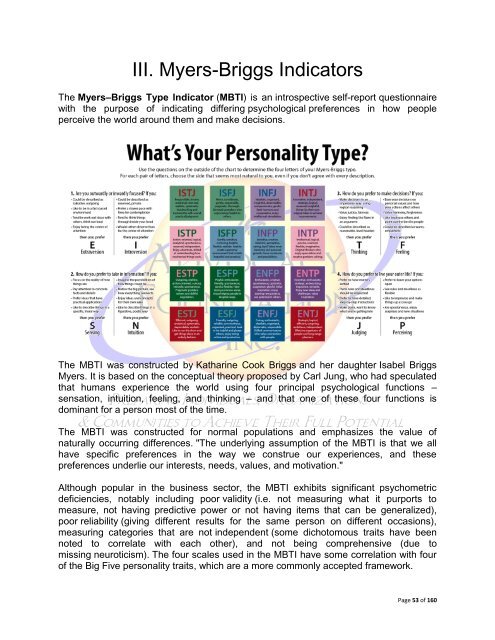The Gift of Introversion
The Gift of Introversion
The Gift of Introversion
Create successful ePaper yourself
Turn your PDF publications into a flip-book with our unique Google optimized e-Paper software.
III. Myers-Briggs Indicators<br />
<strong>The</strong> Myers–Briggs Type Indicator (MBTI) is an introspective self-report questionnaire<br />
with the purpose <strong>of</strong> indicating differing psychological preferences in how people<br />
perceive the world around them and make decisions.<br />
<strong>The</strong> MBTI was constructed by Katharine Cook Briggs and her daughter Isabel Briggs<br />
Myers. It is based on the conceptual theory proposed by Carl Jung, who had speculated<br />
that humans experience the world using four principal psychological functions –<br />
sensation, intuition, feeling, and thinking – and that one <strong>of</strong> these four functions is<br />
dominant for a person most <strong>of</strong> the time.<br />
<strong>The</strong> MBTI was constructed for normal populations and emphasizes the value <strong>of</strong><br />
naturally occurring differences. "<strong>The</strong> underlying assumption <strong>of</strong> the MBTI is that we all<br />
have specific preferences in the way we construe our experiences, and these<br />
preferences underlie our interests, needs, values, and motivation."<br />
Although popular in the business sector, the MBTI exhibits significant psychometric<br />
deficiencies, notably including poor validity (i.e. not measuring what it purports to<br />
measure, not having predictive power or not having items that can be generalized),<br />
poor reliability (giving different results for the same person on different occasions),<br />
measuring categories that are not independent (some dichotomous traits have been<br />
noted to correlate with each other), and not being comprehensive (due to<br />
missing neuroticism). <strong>The</strong> four scales used in the MBTI have some correlation with four<br />
<strong>of</strong> the Big Five personality traits, which are a more commonly accepted framework.<br />
Page 53 <strong>of</strong> 160

















